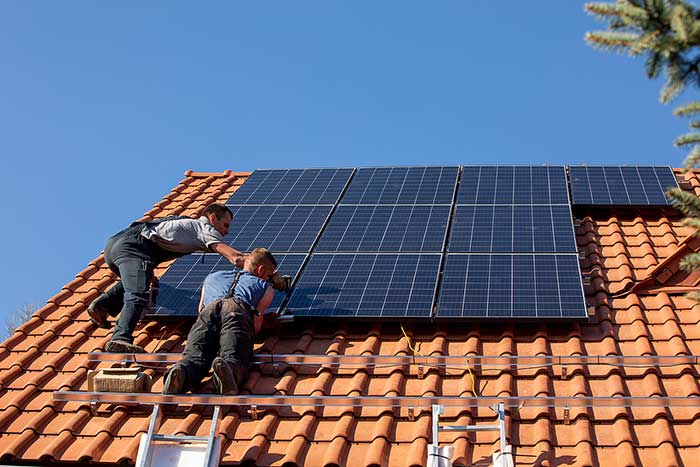
Are you thinking of using solar energy to supply your entire home? If so, you’re not alone. In fact, more and more people have taken advantage of solar roof options.
Yet even those who have gone solar in the past may still struggle to understand solar radiation. If you’re one of these people, this is your lucky day.
Our complete guide has all the info you need to take advantage of the sun’s rays. Keep reading to learn more.
What Is Solar Radiation?
Solar radiation is energy emitted from the Sun in the form of electromagnetic radiation. This radiation is present in the form of the following:
- of-rays
- visible light
- ultraviolet radiation
- infrared radiation
Solar radiation is what supplies us with heat, light, and energy throughout the day and is responsible for supporting most of the plants and organisms on Earth. It affects things like global weather patterns, temperature, and ocean currents.
All objects in the universe emit energy, including the sun. This energy is referred to as solar radiation and is the reason why the earth and its inhabitants are able to exist and thrive.
It is essential for sustainable development, as it helps to meet the energy needs of society. It can be used to power anything from electric cars to homes and is necessary for the upkeep of the planet’s resources.
Solar radiation is one of the most important sources of energy for the world, helping to supply energy to both the developed and developing world.
The Benefits of Solar Radiation
Solar radiation is the light and heat energy coming from the sun, and it has numerous benefits. Solar power panels capture this energy and convert it into usable electricity. It essentially provides clean, renewable electricity.
Solar radiation also provides a renewable way to heat water. It can also operate self-powered systems and power remote areas that don’t have access to the electric grid. Solar energy is also more sustainable than many other energy sources.
It does not generate byproducts or emissions that could harm the environment. Solar radiation is a valuable source of energy for homes, businesses, and communities. Understanding the active radiation of the sun is key to implementing the most efficient and cost-effective system.
You can browse this website on solar panels to help you maximize the benefits of solar radiation. With the right technology, solar can be a great option for reducing energy expenditures and taking advantage of the power of the sun.
How Solar Radiation is Measured
Solar radiation is measured in a variety of ways. One of the most common and widely used methods is called the measurement of solar irradiance.
It is measured by a device known as a pyranometer, which measures the amount of sunlight that is absorbed by a surface over a certain period of time.
Another measure of solar radiation is direct normal solar irradiance (DSNI), which is the amount of solar radiation falling on a surface perpendicular to the sun’s rays.
Measuring Solar Radiation Intensity
Measuring Solar Radiation Intensity involves studying how much energy from the sun is received by an area each day. This is done by using specialized tools to accurately measure the amount of energy (i.e. the intensity of Solar Radiation) the sun is sending to Earth.
These tools are thermocouples, pyranometers, radiometers, and Pyrheliometers. Each tool has specialized sensors that can detect various values of radiation that come from the sun, such as:
- the total solar radiation
- direct normal irradiance
- diffuse horizontal irradiance
- spectral solar irradiance
- global horizontal irradiance
Understanding Solar Radiation Intensity is integral in order to determining factors such as system design, sizing, and performance. Knowledge of these forces can help in ensuring that solar energy is maximized. This is for the greatest possible return in electricity generation or temperature regulation.
Factors Affecting Solar Radiation
Solar radiation is an important factor in the environment. Understanding the factors that influence it is essential. It is affected by various factors, such as:
- the location
- time of year
- location’s altitude
The amount of solar energy reaching the surface of the earth is largely determined by the tilt of the earth’s axis and its distance from the sun. Clouds and atmospheric constituents, like water vapor, aerosols, and greenhouse gases, also play a big role.
They modulate the amount of solar radiation reaching the ground. The amount of solar radiation increases with higher altitudes. This is why the temperatures at higher altitudes are lower than at sea level.
The albedo effect is also influential. Surfaces that are brighter reflect more sunlight than darker surfaces. Urbanization, industrialization, and deforestation can decrease solar radiation due to the decreased amount of land surface reflectivity.
Understanding how these factors affect solar radiation is of utmost importance, as it can provide valuable insight into climate change and energy usage.
Harnessing the Power of Solar Radiation
Solar radiation is one of the most abundant energy sources on Earth. Harnessing the power of solar radiation is an important part of transitioning to a clean, renewable energy future. Solar radiation can be used to generate electricity.
Photovoltaics directly convert sunlight into an electrical current. While thermal systems, on the other hand, use solar thermal collectors. It converts the sun’s energy into heat. That energy is used to generate electricity.
Understanding solar radiation is a key component of designing, building, and optimizing renewable energy systems. The amount and intensity of solar radiation a given area receives are constantly changing. That’s why it must be accurately monitored regularly.
Doing this also ensures the maximum amount of energy is captured. Understand how to measure accurately. Making sure to monitor solar radiation is the first step in harnessing the power of the sun.
A better understanding of solar radiation is vital for revolutionizing the energy industry and reducing our reliance on traditional energy sources.
Understanding Solar Radiation
In conclusion, solar radiation can be incredibly beneficial to our planet’s future. Everyone should take the time to understand it and take advantage of its powerful benefits.
By investing in solar technology and researching the many ways that solar radiation can be harnessed, we can power a brighter future for ourselves and the planet. Take action today and start your solar journey!
Did you find this article helpful? You can check out our website for more awesome content like this.


